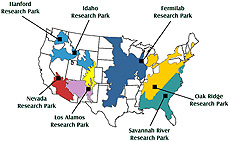This column first appeared in Fermilab Today November 30.
Fermilab is one of seven Department of Energy National Environmental Research Parks.
We all know that Fermilab is a premier high-energy physics laboratory. But did you realize that Fermilab is also one of only seven Department of Energy National Environmental Research Parks in the United States? These parks, or NERPs, began in the early 1970s at outdoor laboratories where research on major US ecosystems could be carried out at a large scale. The first NERP was dedicated at the Savannah River Site in South Carolina in 1972.
The study of natural systems' response to human activities is fundamental to the NERP concept. DOE laboratories offer a unique opportunity to take a close look at both the response and the activities that trigger the natural response.
The Fermilab NERP was created in 1989 to enable the study of the tall grass prairie ecosystem. Since then, the Fermilab NERP has hosted more than 80 research projects from 24 universities, seven non-governmental research institutions (e.g., The Field Museum, Morton Arboretum), and federal and local agencies. Argonne National Laboratory has been a major contributor to this research for three decades. Investigators have studied the biogeochemistry of prairie soils, soil nutrient cycling, atmospheric carbon dynamics, and, most recently, uses for prairie grasses as alternative fuel sources.
Recently, a bill was introduced in Congress to give legislative status to the NERP network members and to authorize annual funding for each of the NERP sites. Coordinators from all the DOE NERPs met last week at Savannah River to discuss the future of research if the funding materializes. All of the NERPs are conducting interesting and important environmental research, and the workshop participants concentrated on exploring the potential for future projects that involve coordinating our efforts to study continental-scale issues like climate change and alternative energy.
Learn more about the DOE NERP program at its Web site.
Each NERP is located in a distinct and important large ecosystem. Fermilab's NERP represents the tall grass prairie.
by Rod Walton, Fermilab ecologist







